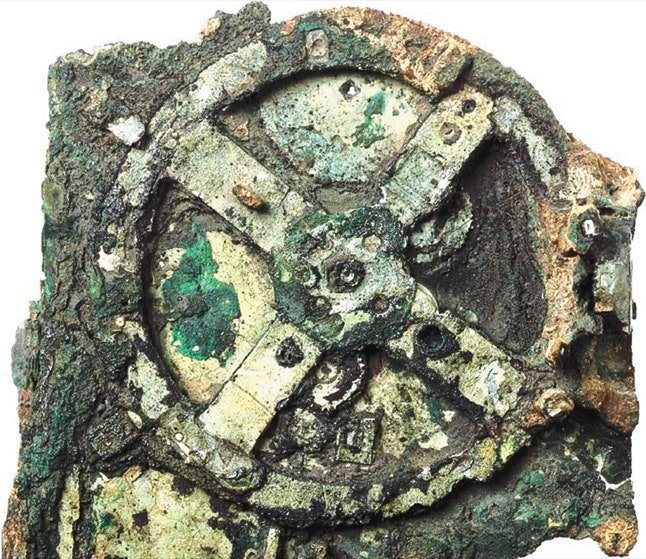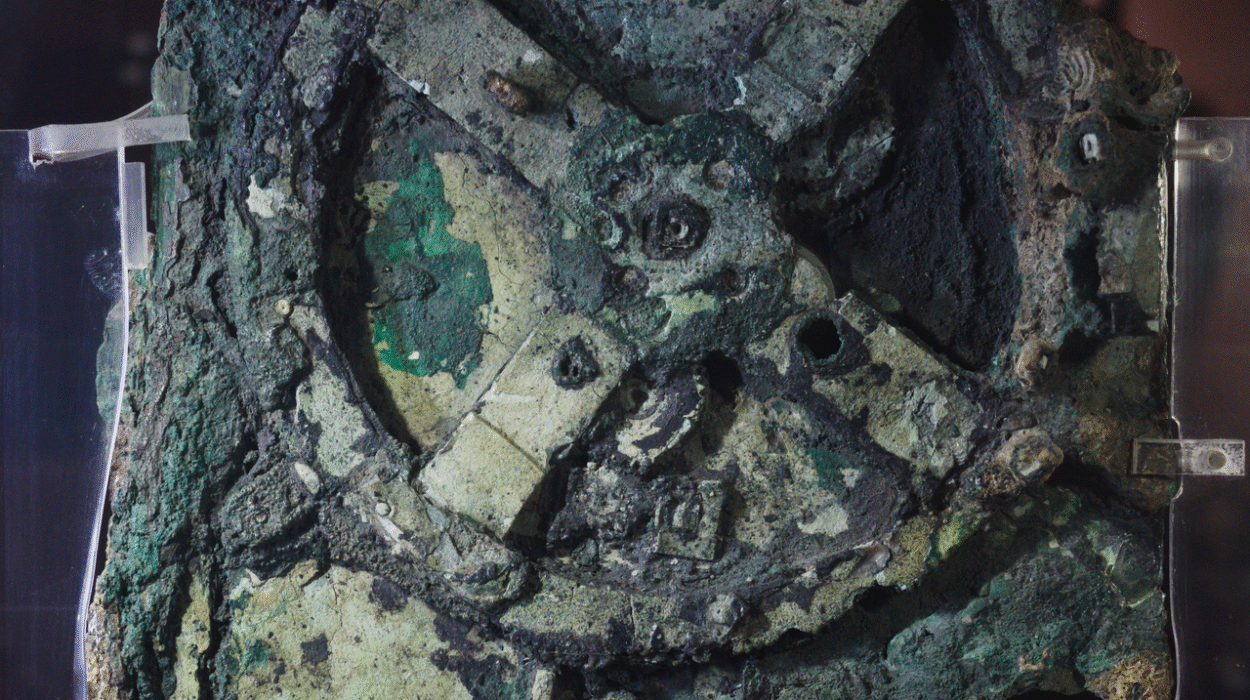History is written in stone, ink, and metal—etched into the monuments we revere, recorded in ancient scrolls, and embedded in the tools left behind by long-lost civilizations. But what happens when objects are found that don’t quite fit the timeline? Artifacts that suggest knowledge too advanced for their era, origins that can’t be explained, or technologies that seem out of place?
These relics are the riddles of archaeology—tantalizing, strange, and often controversial. Some challenge conventional timelines, others hint at forgotten civilizations, and a few seem to rewrite the history of human invention altogether. Though many remain contested by scholars, dismissed as hoaxes, or explained by chance, others continue to defy simple explanation.
Here, we journey through ten of the most mysterious artifacts ever discovered—objects that whisper secrets from the past, and leave us questioning just how much we really know about human history.
1. The Antikythera Mechanism: Ancient Greece’s Computer
In 1901, sponge divers exploring the seafloor off the coast of the Greek island Antikythera stumbled upon the wreckage of an ancient Roman cargo ship. Among statues and amphorae was a corroded lump of bronze that, at first, attracted little attention. But beneath the corrosion lay a network of interlocking gears and inscriptions—an object later hailed as the world’s first analog computer.
The Antikythera Mechanism dates to around 100 BCE. Using x-ray imaging and 3D reconstruction, scientists revealed a complex mechanism designed to predict astronomical positions and eclipses, track the lunar calendar, and even model planetary movements. It used at least 30 bronze gears, some with teeth smaller than a millimeter, precisely crafted in a manner thought impossible for that time.
No other mechanism like it would appear for over a thousand years.
The implications are staggering. Who built it? Where did such precision engineering come from? Was it a singular invention or the legacy of a now-lost tradition of Hellenistic science?
It’s not just an artifact; it’s a message from the ancient world that says: we were more advanced than you thought.
2. The Baghdad Battery: A Spark from Antiquity
Discovered in modern-day Iraq, the so-called Baghdad Battery is a small clay jar containing a copper cylinder and an iron rod. Dating to around 250 BCE, its construction has led some to believe it may have functioned as a primitive galvanic cell—in other words, a battery.
When filled with an acidic solution like vinegar or grape juice, the device can produce a small electric charge. But why would the Parthians or Persians need electricity? There are no written records of electric tools or knowledge from that era.
Some theorists speculate it was used for electroplating gold onto silver, or perhaps for therapeutic purposes. Others argue it was simply a storage vessel, and the electrical interpretation is a modern projection.
Despite the skepticism, the artifact remains enigmatic. If it was a battery, it predates Volta’s “official” invention by nearly two millennia. If it wasn’t—then why does it mimic the form and function of one so precisely?
3. The Voynich Manuscript: A Book No One Can Read
Imagine a book so perplexing, so deeply encoded, that not a single person in recorded history has been able to read it. That is the Voynich Manuscript, a 240-page codex written in an unknown language or code, illustrated with strange plants, naked women in mysterious baths, celestial charts, and unidentifiable diagrams.
Carbon dating places the manuscript in the early 15th century, but its origins and purpose are unknown. Attempts to decipher the text have failed. Cryptographers, linguists, AI models, and even amateur codebreakers have poured over its pages to no avail.
Some believe it’s a medieval hoax, an elaborate fake with meaningless script. Others argue that it encodes alchemical knowledge, forgotten science, or even the remnants of a lost language. A few propose it may be the product of an outsider mind—perhaps even extraterrestrial, though there’s no evidence for this.
Whatever the truth, the Voynich Manuscript continues to resist all attempts at translation. Its very existence is an intellectual dare, a riddle that mocks our best decoding efforts.
4. The London Hammer: A Modern Tool in Ancient Rock
In 1936, a couple hiking near London, Texas, found a piece of wood protruding from a rock formation. On excavation, they uncovered what appeared to be a hammer—with a wooden handle and a metal head—encased in what looked like ancient limestone.
The mystery? The rock was estimated to be over 100 million years old.
Critics argue the rock formation may have encased the hammer through natural concretion over a much shorter time. Yet the hammer itself is made from iron with a composition unlike any modern alloy: 96% iron, 2% chlorine, and 1% sulfur. The iron head has not rusted, even after decades of exposure, leading some to claim it was forged using lost techniques.
Is it a modern tool trapped in ancient stone by coincidence? Or could it suggest that human-like technology existed far earlier than we believe?
5. The Piri Reis Map: A Renaissance Enigma
Drawn in 1513 by Ottoman admiral Piri Reis, this map shows a detailed representation of the known world—including parts of South America, Africa, and, incredibly, a segment of Antarctica’s coast—without ice.
But Antarctica wasn’t discovered until 1820, and satellite imaging confirming its ice-free coastline didn’t exist until the 20th century.
Reis claimed his map was based on much older source maps, some dating back to the time of Alexander the Great. The map is accurate in certain areas beyond what Renaissance knowledge should have allowed. Its depiction of South America, especially the Amazon basin, is strikingly precise.
Skeptics argue that the Antarctic resemblance is coincidental, or the result of misidentified coastline. Others suggest that ancient seafarers may have mapped the globe long before Columbus or Magellan, and that their knowledge was preserved, barely, in scraps that Piri Reis inherited.
Whatever its origins, the map suggests that someone, somewhere, knew more about the world than they should have at the time.
6. The Saqqara Bird: Ancient Egypt’s Glider?
In a tomb in Saqqara, Egypt, archaeologists found a wooden artifact dated to around 200 BCE. Shaped like a bird, it bore no inscriptions, but it had an odd vertical tail and wings with aerodynamic curves—features uncannily reminiscent of a modern glider.
Known as the Saqqara Bird, this 6-inch object sparked debate. Was it a toy? A ceremonial item? Or, as some aeronautical engineers have suggested, a model of a flying machine?
Tests with scaled replicas revealed that the bird could, in theory, glide—if modified with a stabilizing tail. Some claim this supports the notion that ancient Egyptians may have had basic knowledge of aerodynamic principles.
Though mainstream scholars dismiss such interpretations as speculative, the artifact remains unique. Why would an object from a civilization that never flew resemble a modern aircraft?
It might be a coincidence—or it might hint at knowledge lost in the sands of time.
7. The Dropa Stones: A Cosmic Message?
In 1938, a Chinese expedition to the Baian-Kara-Ula mountains allegedly uncovered a series of stone discs buried in cave systems. These Dropa Stones were said to be over 12,000 years old, each inscribed with microscopic grooves that spiraled inward like a phonograph record.
According to controversial reports, the grooves were eventually decoded by Dr. Tsum Um Nui, who claimed they told the story of a crash landing by extraterrestrials, the Dropa, who became stranded on Earth and interbred with local tribes.
Mainstream scholars have dismissed the stones as myth or fabrication, noting a lack of evidence and poor documentation. Yet the legend persists, partly because the original stones have since disappeared from public record.
Are the Dropa Stones an elaborate hoax? A lost artifact? Or perhaps a cautionary tale about how history, once buried, can never fully be trusted to remain unchanged?
8. The Coso Artifact: Technology in Ancient Sediment
In 1961, near Olancha, California, rock collectors found a geode-like object that, when broken open, revealed something unexpected: a small metal cylinder with a porcelain core, resembling a modern spark plug, embedded in what seemed to be solid rock.
Known as the Coso Artifact, it sparked a firestorm of speculation. The rock was estimated to be at least 500,000 years old, though skeptics say it may have simply formed around the object through concretion.
Even if not prehistoric, the presence of what seems to be modern machinery in a sealed stone matrix defies expectations.
Most mainstream scientists consider it a case of mistaken dating or natural geological processes. Still, for fringe theorists, it’s a shining example of anomalous technology—a potential hint that our technological timeline may have deeper roots than we realize.
9. The Dendera Light: Electric Power in Ancient Egypt?
In the temple of Hathor at Dendera, Egypt, relief carvings depict what appear to be large, bulb-like structures, with serpents inside them and lotus stems acting like cables. Accompanying figures seem to be operating or revering these strange objects.
Some alternative theorists believe this is evidence of ancient electrical lighting, a theory bolstered by the lack of soot found in many tombs, despite claims that torches were used.
Mainstream Egyptologists interpret the carvings as symbolic depictions of mythology, representing aspects of creation and divine energy. They argue that the “bulbs” are stylized lotus flowers and that the “cables” are representations of Djed pillars.
Still, the resemblance to electrical technology is striking, and the theory continues to spark debate. Could the ancient Egyptians have developed a form of primitive electricity for ceremonial purposes—or is this simply a case of pareidolia, our tendency to find familiar patterns in the unfamiliar?
10. The Shroud of Turin: A Divine Photograph?
Perhaps no artifact stirs both devotion and debate like the Shroud of Turin, a linen cloth bearing the faint image of a man who appears to have suffered crucifixion. Venerated by many as the burial shroud of Jesus Christ, it has been the subject of scientific scrutiny for decades.
Radiocarbon dating in 1988 suggested the shroud was made between 1260 and 1390 CE, but supporters argue that contamination and damage have skewed the results. Pollen found on the cloth matches plants found in the Jerusalem area, and the image itself—believed by some to be a photographic negative—has no clear explanation.
Theories abound: it’s a medieval forgery, a miraculous imprint, or the product of unknown artistic methods. The exact mechanism behind the image’s formation remains elusive.
Is it a spiritual relic, a clever fake, or an artifact of lost science?
Conclusion: The Past Is Not Silent
Artifacts are more than objects; they are messengers from the past. Most speak clearly, telling stories of everyday life, trade, war, and culture. But some whisper riddles. They challenge assumptions, blur timelines, and invite us to reconsider what we think we know about history.
Skeptics and scientists rightly demand evidence, and many of these artifacts remain in the limbo between fringe theory and accepted history. Yet their mysteries endure.
Perhaps the greatest mystery is not what these artifacts are—but what they reveal about us: our willingness to question, to dream, and to search for truth in the quiet corners of time.
Until every puzzle is solved, the past will continue to haunt the present—one artifact at a time.



